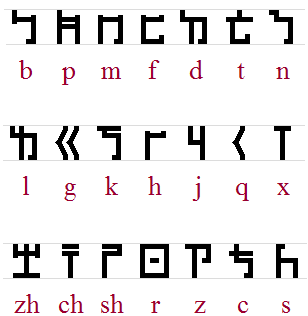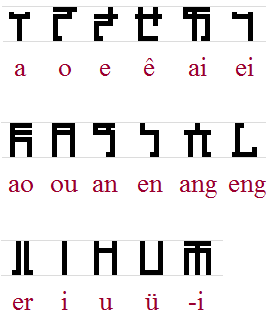The writing system referred to as Bopomofo (from its first four sounds) is called Zhuyin Fuhao “phonetic symbols” in Chinese. It was devised by committee around 1913, and had some use alongside the millenia-old logographic system for Chinese, until 1949. It still has some use in Taiwan. The shapes for Bopomofo were created by Zhang Binglin, and are mostly derived from old or simple Chinese glyphs, used as a shorthand for their sound.
Onset Consonants
The font presented here is a squared, stylized version of the original. After having seen printed examples similar to this from the 1930s, it seemed to me that the common usage today—resembling traditional Chinese letters done by brush—somewhat misses the point of this modern, sophisticated system. In stylizing the glyphs, I still refer to the ancient source shapes, but have taken away curves and diagonals. The labels are standard pinyin.
Rimes and Tones
The script was designed for Mandarin Chinese; most syllables are made of two parts, an onset (one of the above) followed by a coda, which may have a nasal consonant as final. Syllables starting with /y/ or /w/ use the vowel symbols /i/ or /u/ as onset. The last vowel here is the minimal vowel of those consonants in the last row of the chart above (/zh/ to /s/), usually written as /i/ in pinyin.
The tone marks in this variation sit above the vowel, rather than floating off to the right of it. Note that the unmarked tone is high, and neutral tone is marked with a dot. Shown here with vowel /a/.



